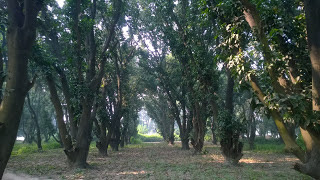Most of us living in the cities have no
idea of the hardships faced by people living in the villages in India. As
electricity, broadband connectivity, healthcare and commuter services reach our
villages I have seen the living standards improving tremendously in the last 3
decades, but life is still not as rosy as in the picture postcard villages of Europe.
Still city folks have long dreamt of a cottage in a village, a fully furnished
air-conditioned one naturally, by the side of a flowing stream with a large flowering
garden and a rich vegetable patch and lots of chirping birds and a wide variety
of butterflies!
Yes all this can exist in reality but it
will also come with barking stray dogs, wandering stray cattle and at times
wild boars and a rampaging herd of blue bulls (Nilgais). We have a small farm
at the outskirts of Lucknow in a place called Bakshi ka Talab. We have had this farm for almost three
decades and though we may not know all the villagers in our village by name,
but they all know and recognize us and our children. The fact that Neeta, my
wife and I are both doctors also helps and we become their nodal persons in
Lucknow for any health problem, particularly health emergencies.
 |
| Jack fruits on a tree |
We also have a pond, and initially had
fishes in it. We purchased tiny carps in hundreds from Kolkata, got them
delivered in Lucknow by train and set them free in the pond. We enjoyed seeing
them grow in size for some time and also sold them in the market, but three
years of successive drought caused the pond to dry up and this adventure of
fish farming had a sorry ending.
While life in cities ground to a halt in
recent weeks, a social media trend known as "cottagecore" has been
thriving online, drawing a young, cool crowd to the English countryside. At its
heart, cottagecore is a romanticised interpretation of countryside life. These
new influencers are girls dressed in gingham who frolic among bluebells, knead
bread in moss-covered boltholes and tend to organic vegetable patches. In the
cottagecore universe, there are no phones pinging constantly with updates, no
urgent work emails, no evenings spent responding to the onerous demands of a
tyrannical boss. In fact, there is no labor beyond domestic, and workaday tasks
are completed with a gauzy sense of fulfillment. Each pie appears to emerge
effortlessly from the oven with immaculate golden brown lattice crust.
 |
| A picture postcard cottage from Instagram |
While in recent years, platforms such as
Instagram have become a breeding ground for millennial foragers, bakers and
farmers alike, all keen to spread the pleasure of living simply, it seems time
spent in lockdown has fast forwarded this hankering for "The Good
Life". Real estate agents in U.K and Australia are reporting an increase in enquiries for
rural properties, as people start to think about alternative lifestyles
now home working has become the norm.
Ms. Abigail Janine is a 24-year-old
cottagecore influencer. After dropping out of university, where she was
training to be a nurse, she found solace in the cottagecore community, and
posts regularly to her 10,700 Instagram followers from her home in rural
Colchester, UK. "It's the idea of living in what you create – escapism
from the fast-paced environment we all live in," she said. "My mental
health has improved enormously after making the slow lifestyle a
priority." This lady has a style which attracts me; one of her posts is a
video entitled "the art of slow living", a 15-second clip of a small
snail atop a sun-drenched rock – a reminder to "rebalance your energy and
remember relaxing is far from a waste of time" – while a soothing piano
melody chimes in the background.
There are many like Abigail who crave for her
lifestyle but don't have access to the natural world. The urban middle class in
India is trying to buy this! You too can dream of this but before that remember
getting some natural air flow and sunlight in your home by opening curtains and
windows and potting some indoor plants can help improve air quality, lift your
mood and reconnect you with nature. Try this as the first step, don’t rush to
buy a farm patch.
We have purposely refrained from
constructing a farm house in our farm because the purpose of this project as
not to have a holiday home. We wanted our children to understand the journey
their food takes from the farm to their dinner plate and to appreciate the
effort that goes into this process. We were not planning to bring up an
enviable property, nor were we planning to grow crops and trees. We were
planning to bring up two children and let them grow into sensible and compassionate
human beings, deeply rooted in the realities of life and yet aiming for the
sky. This farm, I must say, has served this purpose admirably and so every
Diwali we go there in the morning to offer puja and distribute sweets and gifts
to all those who work there and toil it out. This is our way of saying ‘thank
you’ to all these guys.
In all the hustle and bustle of daily
life, we may not regularly visit the farm but it remains an ideal stress buster
in our life. It is certainly not a profit making venture, but it sustains
itself and the people who work in it. And it gives us a lot of joy!


Nice. You did something different. It keeps one connected with the village and creates a sense of belongingness.
ReplyDelete